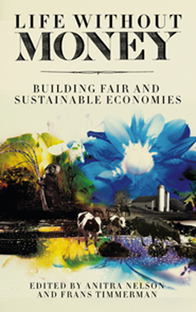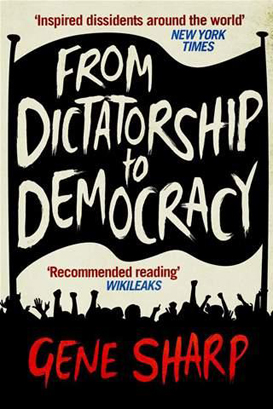Book Reviews: ‘Life without Money’, ‘From Dictatorship to Democracy’
Gifts and Giving
Life without Money. Anitra Nelson and Frans Timmerman, eds. Pluto £16

Several of the chapters in this volume are based on work which has appeared elsewhere. For instance, the chapter by Socialist Party member Adam Buick re-uses passages from the Socialist Standard.
It is certainly refreshing to come across a book that deals seriously with the idea of a world without money. As the editors say in the first chapter, ‘for us non-market socialism means a money-less, market-less, wage-less, class-less and state-less society that also aims to satisfy everyone’s basic needs while power and resources are shared in just and “equal” ways.’ A number of different perspectives on such a society are presented, some of which are more persuasive than others.
Two chapters look at small-scale attempts to live without money. One deals with the Twin Oaks intentional community in Virginia (http://twinoaks.org), which relies on a very complex system of labour credits. The other covers the squatter community in the Barcelona area. The squatters live by, for instance, recycling food (which would otherwise be dumped) from the port area, but they do need small amounts of money.
John O’Neill and Adam Buick deal with the economic calculation argument that in socialism there can be no single unit by means of which alternative actions can be compared (such as prices supposedly provide under capitalism). They point out that no such unit would be needed, since decisions can be taken by considering alternatives directly. Nor is some vast central plan needed.
Terry Leahy contributes an interesting essay on a gift economy where ‘products are either consumed directly by producers or made available to others as gifts’. This is a standard concept in the work of anthropologists looking at pre-modern (and some modern) societies, and it’s worth entering ‘gift economy’ in an internet search engine. It might be acceptable as a partial characterisation of socialism, except that in a complex industrial society producers cannot consume much of their own products, and most goods are produced by many different workers co-operating at different stages. Leahy also emphasises the role that might be played by hybrids of a gift economy and capitalism, developments which involve increased control of production and distribution by producers on some basis other than profit. The idea is that these hybrids could gradually be expanded so that ultimately a gift economy could take over from capitalism completely. Now, it’s possible that, as the socialist movement grows, hybrid-type arrangements will become more common, as people increasingly reject wage labour, but it will hardly be possible for this to replace a revolution to make the world’s resources common property.
A final chapter by the editors reinforces this notion of a gradual changeover, including the idea of ‘non-monetary exchange’ (as opposed to the socialist proposal to abolish exchange entirely). Despite this, though, the volume as a whole offers a refreshing look at alternatives to capitalism.
PB
Defying dictatorships
From Dictatorship to Democracy: A Conceptual Framework for Liberation. By Gene Sharp. Serpent’s Tail, 2011.
 Gene Sharp is an American scholar who has already published several works about non-violent popular action or – the term he now prefers – “political defiance” as a strategy to weaken and eventually “disintegrate” dictatorial regimes or as a civilian-based defence against military occupation. This latest book, written at the request of an exiled Burmese dissident, summarises the conclusions he has reached over forty years of research. It has appeared in over thirty languages and is said to have influenced many of the recent anti-dictatorship movements throughout the world.
Gene Sharp is an American scholar who has already published several works about non-violent popular action or – the term he now prefers – “political defiance” as a strategy to weaken and eventually “disintegrate” dictatorial regimes or as a civilian-based defence against military occupation. This latest book, written at the request of an exiled Burmese dissident, summarises the conclusions he has reached over forty years of research. It has appeared in over thirty languages and is said to have influenced many of the recent anti-dictatorship movements throughout the world.
Sharp does not play down the enormous difficulties facing any non-violent movement that takes on a well-entrenched dictatorship. Those who start such a movement must be prepared for a long struggle, with setbacks and numerous casualties (after all, only one side is committed to non-violence). Nor is there any guarantee of success, even in the long run.
All the same, he argues, violent resistance (other things being equal) entails even larger casualties and has even poorer prospects of success. That is because it strikes at the strongest point of a dictatorship – its capacity for violent coercion. Non-violent defiance aims at a dictatorship’s weakest point or Achilles heel – its need for the cooperation of the people it rules.
A dictatorship can manage without broad active support, but its functioning does depend on a certain minimum of passive toleration and compliance with its demands. Beyond some point, the withdrawal of cooperation undermines the effectiveness and cohesion of a regime and the reliability of its armed forces to such an extent that it just falls apart.
Much of the book consists of advice about how to design and implement a strategic plan of political defiance. On the whole, the advice seems sensible enough. For instance, Sharp urges activists to develop a campaign by gradual stages, maintaining non-violent discipline and avoiding premature mass protests that expose protestors to wholesale slaughter.
In practice, however, the scope for such careful strategising is limited. Popular protest tends to spread spontaneously, influenced less by rational calculation than by emotion, including a desire to copy movements in other countries where conditions may be very different. Thus, imitation of the successful non-violent movements in Tunisia and Egypt led to massacre and civil war in Libya and now Syria.
Sharp points out that the disintegration of a dictatorial regime does not necessarily lead to democracy. Another possible outcome is a military coup. However, he does not face the fact that far from all anti-dictatorship activists merit the label of “democrat”. In quite a few places – not only Moslem countries but also Russia, for instance – many of those protesting against an existing dictatorship merely seek to replace it with a dictatorship of a different type, one they hope will be less corrupt and have stronger nationalist or religious credentials.
This brings us to a problem that Sharp mentions but never tackles head on. What attitude should anti-dictatorship movements take toward possible assistance from foreign governments, whether financial, diplomatic or military (e.g., no-fly zones)? Sharp encourages movements to seek such assistance, on the principle that they need to mobilise whatever resources they can. Yet he also suggests, though without explaining why, that it is best to rely on foreign governments as little as possible.
When the American government (to take the most important case) promotes “regime change” abroad, it does so for strategic and economic reasons that have nothing whatsoever to do with democracy. Perhaps Sharp knows this. If so, why would he be so coy? One thing is for sure: an honest analysis of U.S. foreign policy would hardly have earned his book the rave reviews it received in the New York Times and Wall Street Journal.
Despite these criticisms, I recognise the importance of Sharp’s basic argument about the potential of non-violent political defiance and its advantages over armed struggle. Indeed, it is relevant in a much broader context than that of the struggle against dictatorship.
Although there is a significant difference between democratic and dictatorial regimes, political democracy under capitalism is bound to be limited and unstable because capitalism is inherently anti-democratic as an economic system. In recent years, democratic rights have been seriously undermined in Western countries under the pretext of the “war against terror”. So non-violent action is needed not only to establish democracy where it does not exist, but also to preserve it where it is at risk.
The class struggle has mostly taken forms consistent with Sharp’s concept of “defiance” – expanded to include defiance of employers as well as the state. This applies to strikes and picketing, which Sharp includes in his list of “methods of non-violent action”, as well as to the methods used, for instance, to resist house foreclosures.
Non-violent popular action can also play an important role in moving forward from limited political democracy to full social democracy, which is what we mean by socialism. Not as a substitute for electoral and constitutional action, but as an additional guarantee that the socialist majority will achieve its goal under any conceivable circumstances.
STEFAN
